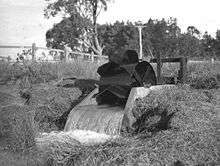Dethridge wheel
The Dethridge wheel is used throughout Australia and in many other countries, including the United States, Israel and in Africa, to measure the flow of water delivered to farms for irrigation. The wheel was invented by John Dethridge in Australia in 1910. Dethridge was then commissioner for the State Rivers and Water Supply Commission of Victoria.[1]

The wheel consists of a drum on an axle, with eight v-shaped vanes fixed to the outside. It sits laterally across a channel and is turned by water flow. The revolving wheel measures flow from the irrigation supply channels into the farm channels, providing the basis upon which irrigation farmers are charged for water. Wheels generally last for 15 to 20 years, and the axle is replaced every 5 years.[2]
References
| Wikimedia Commons has media related to Dethridge wheels. |
- Stein, Thomas M. "Dethridge meter (cumulative flow)". Sakia.org Irrigation Index. Retrieved 2007-02-25.
- "99/97/1 Water meter, Dethridge wheel, steel, used by Murrumbidgee Irrigation Pty Ltd, Australia, 1990". Powerhouse Museum Collection 2.0. Powerhouse Museum. Retrieved 2007-02-25.
- Green, KD (2000) [1988]. "Irrigation Development". Measuring farm supplies—the Dethridge wheel. Technology in Australia. Parkville, Victoria, AU: Australian Academy of Technological Sciences and Engineering. p. 157. ISBN 0-908029-49-7. Retrieved 2007-02-21.